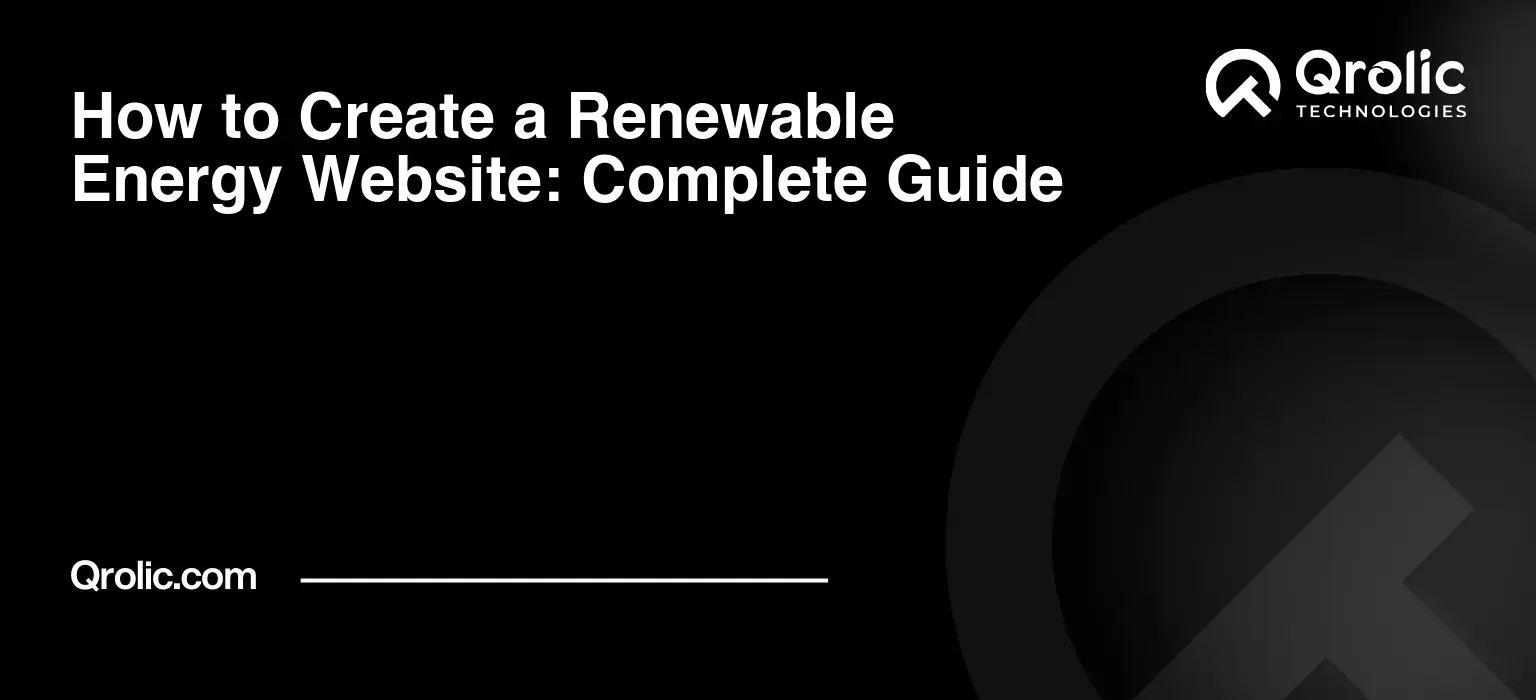Quick Summary:
- Plan your website with clear goals and audience.
- Choose right tools, create great content, and design well.
- Generate leads, promote your site, and track performance.
- Avoid common mistakes like slow speed or bad security.
Table of Contents
- Chapter 1: Laying the Foundation – Why Your Renewable Energy Website Matters
- 1.1. The Power of Online Presence in a Green World
- 1.2. Reaching Your Audience: Who Are You Talking To?
- 1.3. Setting Clear Goals: What Do You Want to Achieve?
- 1.4. The Importance of Green Energy Design and User Experience
- Chapter 2: Choosing the Right Platform and Tools
- 2.1. Content Management Systems (CMS): Your Digital Command Center
- 2.2. Domain Name and Hosting: Your Digital Address
- 2.3. Essential Plugins and Extensions
- 2.4. Design Tools: Bringing Your Vision to Life
- Chapter 3: Content is King: Crafting Compelling and Informative Content
- 3.1. Keyword Research: Understanding What Your Audience Searches For
- 3.2. Creating High-Quality Content: Answering Your Audience’s Questions
- 3.3. Optimizing Content for Search Engines (SEO)
- 3.4. Building Trust and Authority: Demonstrating Expertise
- Chapter 4: Designing a Visually Appealing and User-Friendly Website
- 4.1. Choosing the Right Theme or Template: First Impressions Matter
- 4.2. Color Psychology and Branding: Evoking the Right Emotions
- 4.3. Typography: Making Your Content Readable and Engaging
- 4.4. Optimizing Images and Videos: Enhancing Visual Appeal and Performance
- Chapter 5: Generating Leads and Converting Visitors into Customers
- 5.1. Call-to-Actions (CTAs): Guiding Visitors to Take Action
- 5.2. Lead Capture Forms: Building Your Email List
- 5.3. Landing Pages: Focusing on Specific Offers
- 5.4. Email Marketing: Nurturing Leads and Building Relationships
- 5.5. Customer Relationship Management (CRM): Managing Your Interactions
- Chapter 6: Promoting Your Renewable Energy Website
- 6.1. Search Engine Optimization (SEO): Getting Found on Google
- 6.2. Social Media Marketing: Engaging Your Audience and Driving Traffic
- 6.3. Content Marketing: Creating and Sharing Valuable Resources
- 6.4. Paid Advertising: Reaching a Wider Audience Quickly
- 6.5. Public Relations: Building Awareness and Credibility
- Chapter 7: Monitoring, Analyzing, and Improving Your Website
- 7.1. Website Analytics: Tracking Your Performance
- 7.2. Heatmaps and User Recordings: Understanding User Behavior
- 7.3. A/B Testing: Optimizing Your Website for Conversions
- 7.4. Gathering User Feedback: Listening to Your Audience
- 7.5. Continuous Improvement: Staying Ahead of the Curve
- Chapter 8: Qrolic Technologies: Your Partner in Renewable Energy Website Development
- 8.1. Our Expertise in Renewable Energy Website Development
- 8.2. Why Choose Qrolic Technologies?
- 8.3. Our Commitment to Sustainability
- 8.4. Contact Us Today
- Chapter 9: Common Mistakes to Avoid
- 9.1. Neglecting Mobile Optimization
- 9.2. Ignoring Website Security
- 9.3. Slow Loading Speeds
- 9.4. Poor Navigation
- 9.5. Lack of Clear Call-to-Actions
- 9.6. Ignoring Analytics
- Conclusion: Powering the Future with a Strong Online Presence
Chapter 1: Laying the Foundation – Why Your Renewable Energy Website Matters
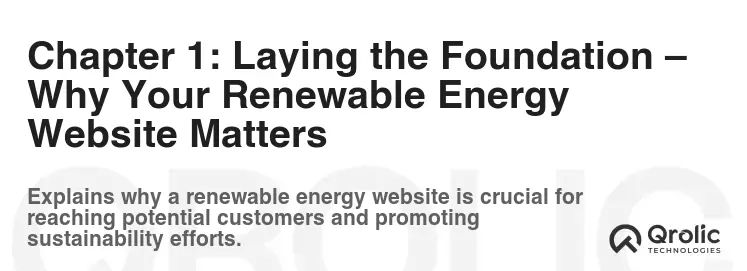
1.1. The Power of Online Presence in a Green World
Why bother building a renewable energy website? In a world desperately seeking sustainable solutions, an online presence is more than just a nice-to-have; it’s a necessity. Think of your website as your digital storefront, your 24/7 advocate for clean energy. It’s where you educate, inspire, and convert visitors into customers or supporters. It’s the cornerstone of your marketing strategy in the burgeoning green sector. The internet is now where people search for products and services, and renewable energy is no exception.
1.2. Reaching Your Audience: Who Are You Talking To?
Understanding your target audience is critical. Are you targeting homeowners seeking solar panel installation? Businesses aiming to reduce their carbon footprint? Investors looking for green opportunities? Tailoring your website’s content and design to resonate with your specific audience segments will dramatically increase engagement and conversions.
Consider these target audience personas:
- The Eco-Conscious Homeowner: Driven by environmental concerns and potential cost savings. They’re looking for information on solar panels, energy efficiency tips, and government incentives.
- The Sustainability-Focused Business: Seeking to improve their corporate social responsibility (CSR) profile and reduce operational costs. They’re interested in large-scale renewable energy solutions, energy audits, and carbon offsetting programs.
- The Renewable Energy Investor: Looking for profitable investment opportunities in the green energy sector. They need access to data, market analysis, and information on renewable energy projects.
- The Student/Researcher: Looking for information to help them in studies or research. They need updated and trustworthy data to help them.
1.3. Setting Clear Goals: What Do You Want to Achieve?
Before diving into design and code, define your website’s purpose. What specific goals do you want to achieve? Common goals include:
- Generating Leads: Capturing contact information from potential customers interested in your products or services.
- Building Brand Awareness: Establishing your company as a trusted authority in the renewable energy sector.
- Educating the Public: Raising awareness about the benefits of renewable energy and promoting sustainable practices.
- Driving Sales: Selling renewable energy products or services directly through your website.
- Recruiting Talent: Attracting skilled professionals to join your team.
1.4. The Importance of Green Energy Design and User Experience
A website for the renewable energy sector needs to walk the walk. Green energy design isn’t just about aesthetics; it’s about demonstrating your commitment to sustainability through your online presence.
- Website Hosting: Choose a web host that powers their servers with renewable energy. This shows the customers and search engine that you are in the right business.
- Minimalism and Efficiency: Clean, uncluttered layouts not only improve user experience but also reduce page load times, minimizing energy consumption.
- Sustainable Practices: Optimize images for web use to reduce file sizes. Implement caching to reduce server load.
- Mobile-First Design: Ensure your website is responsive and performs flawlessly on mobile devices, as many users access the internet via smartphones.
A positive user experience (UX) is equally crucial. A website that is easy to navigate, informative, and visually appealing will keep visitors engaged and encourage them to take action.
Chapter 2: Choosing the Right Platform and Tools
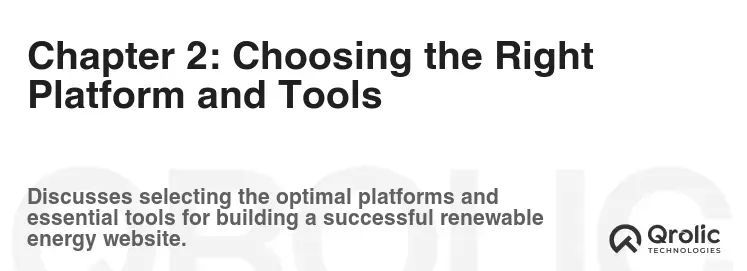
2.1. Content Management Systems (CMS): Your Digital Command Center
A Content Management System (CMS) empowers you to manage your website’s content without needing to be a coding expert. Several excellent options are available, each with its strengths and weaknesses.
- WordPress: The most popular CMS, WordPress offers unparalleled flexibility and a vast library of themes and plugins. Ideal for businesses of all sizes, from small startups to large corporations. It is the best choice for SEO purposes.
- Pros: Highly customizable, SEO-friendly, large community support, extensive plugin ecosystem.
- Cons: Requires some technical knowledge, security vulnerabilities if not properly maintained.
- Joomla: A robust CMS suitable for complex websites with advanced features. It offers excellent multilingual support and user management capabilities.
- Pros: Powerful features, good for complex websites, strong multilingual support.
- Cons: Steeper learning curve than WordPress, fewer themes and plugins available.
- Drupal: A highly flexible and secure CMS favored by government agencies and large organizations. It’s ideal for websites with complex data structures and custom functionality.
- Pros: Highly secure, flexible, suitable for complex websites.
- Cons: Steepest learning curve, requires advanced technical skills.
- Wix/Squarespace: User-friendly website builders ideal for small businesses with limited technical expertise. They offer drag-and-drop interfaces and pre-designed templates.
- Pros: Easy to use, drag-and-drop interface, no coding required.
- Cons: Limited customization options, less SEO-friendly than WordPress.
2.2. Domain Name and Hosting: Your Digital Address
Your domain name is your website’s address on the internet. Choose a domain name that is relevant to your business, easy to remember, and reflects your brand. Ideally, it should include keywords related to renewable energy.
Web hosting is where your website’s files are stored. Choose a reliable hosting provider that offers fast loading speeds, excellent uptime, and responsive customer support. Consider eco-friendly hosting providers that power their servers with renewable energy.
2.3. Essential Plugins and Extensions
Plugins and extensions extend the functionality of your CMS. Here are some essential plugins for a renewable energy website:
- SEO Plugin (Yoast SEO, Rank Math): Helps you optimize your website for search engines.
- Contact Form Plugin (Contact Form 7, WPForms): Enables visitors to contact you easily.
- Security Plugin (Wordfence, Sucuri): Protects your website from hackers and malware.
- Caching Plugin (WP Rocket, LiteSpeed Cache): Improves website loading speed.
- Image Optimization Plugin (Smush, Imagify): Compresses images to reduce file sizes.
- Social Media Sharing Plugin (Social Warfare, AddToAny): Makes it easy for visitors to share your content on social media.
- Analytics Plugin (Google Analytics Dashboard for WP): Tracks website traffic and user behavior.
- eCommerce Plugin (WooCommerce): For selling renewable energy products or services online.
- Lead Generation Plugin (HubSpot, OptinMonster): Captures leads and builds your email list.
2.4. Design Tools: Bringing Your Vision to Life
- Adobe Creative Suite (Photoshop, Illustrator): For creating visually appealing graphics and images.
- Canva: A user-friendly design tool for creating social media graphics, presentations, and marketing materials.
- Figma/Sketch: Collaborative interface design tools for creating website mockups and prototypes.
- Google PageSpeed Insights: Tests your website loading speed and provides recommendations for improvement.
- GTmetrix: Another tool for analyzing website performance and identifying areas for optimization.
Chapter 3: Content is King: Crafting Compelling and Informative Content
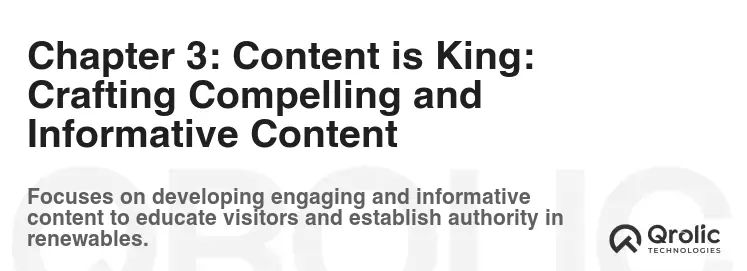
3.1. Keyword Research: Understanding What Your Audience Searches For
Keyword research is the foundation of your content strategy. Identify the keywords that your target audience uses when searching for information about renewable energy. Use keyword research tools like Google Keyword Planner, SEMrush, Ahrefs, and Moz Keyword Explorer to find relevant keywords with high search volume and low competition.
Focus on long-tail keywords (phrases with three or more words) as they are often less competitive and more specific. For example, instead of targeting the keyword “solar panels,” target “best solar panels for home in California.”
3.2. Creating High-Quality Content: Answering Your Audience’s Questions
Your website’s content should be informative, engaging, and optimized for search engines. Focus on creating high-quality content that answers your audience’s questions and provides valuable insights.
- Blog Posts: Share your expertise on topics related to renewable energy. Write about industry trends, new technologies, case studies, and tips for saving energy.
- Case Studies: Showcase your successful projects and demonstrate the benefits of your products or services.
- White Papers: Provide in-depth analysis and research on specific topics related to renewable energy.
- Infographics: Visualize data and information in an engaging and easy-to-understand format.
- Videos: Create videos that explain complex topics, showcase your products, or provide tutorials.
- FAQ Section: Answer common questions about renewable energy and your business.
- Glossary of Terms: Define technical terms related to renewable energy to help your audience understand the industry.
- Landing Pages: Create dedicated landing pages for your products or services, optimized for conversions.
3.3. Optimizing Content for Search Engines (SEO)
- Keyword Integration: Naturally incorporate your target keywords into your content, including the title, headings, and body text.
- Meta Descriptions: Write compelling meta descriptions that entice users to click on your search results.
- Image Optimization: Use descriptive alt tags for your images to improve accessibility and SEO.
- Internal Linking: Link to other relevant pages on your website to improve navigation and SEO.
- External Linking: Link to authoritative websites to add credibility to your content.
- Mobile-Friendliness: Ensure your website is responsive and performs well on mobile devices.
- Page Speed: Optimize your website for speed to improve user experience and SEO.
- Schema Markup: Implement schema markup to provide search engines with more information about your content.
3.4. Building Trust and Authority: Demonstrating Expertise
Establish yourself as a trusted authority in the renewable energy sector by:
- Sharing Data and Statistics: Back up your claims with credible data and statistics from reputable sources.
- Featuring Testimonials and Reviews: Showcase positive testimonials and reviews from satisfied customers.
- Highlighting Awards and Certifications: Display any awards or certifications that your company has received.
- Contributing to Industry Publications: Write articles or guest posts for industry publications to share your expertise.
- Participating in Industry Events: Attend and speak at industry events to network with other professionals and share your knowledge.
- Creating a Strong “About Us” Page: Tell your company’s story and highlight your mission, values, and expertise.
Chapter 4: Designing a Visually Appealing and User-Friendly Website
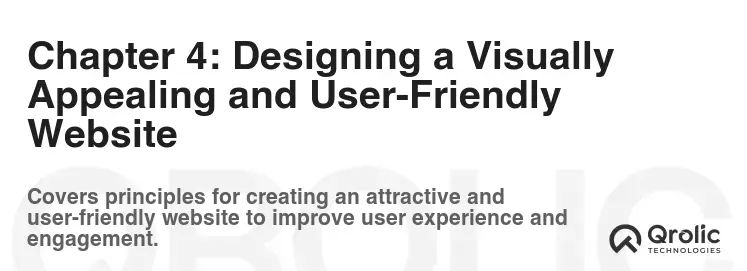
4.1. Choosing the Right Theme or Template: First Impressions Matter
Your website’s design is crucial for attracting and retaining visitors. Choose a theme or template that is visually appealing, user-friendly, and reflects your brand.
- Clean and Modern Design: Opt for a clean and modern design that is easy to navigate.
- Responsive Design: Ensure your website is responsive and adapts to different screen sizes.
- Brand Consistency: Use your brand colors, fonts, and logo consistently throughout your website.
- High-Quality Images: Use high-quality images that are relevant to your content.
- Easy Navigation: Make it easy for visitors to find what they are looking for with clear navigation.
- Call to Actions (CTAs): Use clear and concise CTAs to guide visitors to take the desired action.
4.2. Color Psychology and Branding: Evoking the Right Emotions
Colors evoke emotions and can influence user behavior. Choose colors that align with your brand and the message you want to convey.
- Green: Represents nature, sustainability, and growth.
- Blue: Represents trust, reliability, and stability.
- Yellow: Represents energy, optimism, and happiness.
- Orange: Represents enthusiasm, creativity, and warmth.
Use your brand colors consistently throughout your website to create a cohesive and recognizable brand identity.
4.3. Typography: Making Your Content Readable and Engaging
Choose fonts that are easy to read and visually appealing. Use a combination of headings and body text to create a clear hierarchy and improve readability.
- Serif Fonts: Traditional fonts that are often used for headings.
- Sans-Serif Fonts: Modern fonts that are often used for body text.
Ensure your font size is large enough to be easily read on all devices.
4.4. Optimizing Images and Videos: Enhancing Visual Appeal and Performance
Images and videos can enhance the visual appeal of your website and make your content more engaging. However, they can also slow down your website’s loading speed if not properly optimized.
- Compress Images: Compress images to reduce file sizes without sacrificing quality.
- Use the Right File Format: Use JPEG for photos and PNG for graphics with transparency.
- Optimize Videos: Optimize videos for web use by reducing file sizes and using a video hosting platform like YouTube or Vimeo.
- Use Lazy Loading: Implement lazy loading to load images and videos only when they are visible on the screen.
Chapter 5: Generating Leads and Converting Visitors into Customers
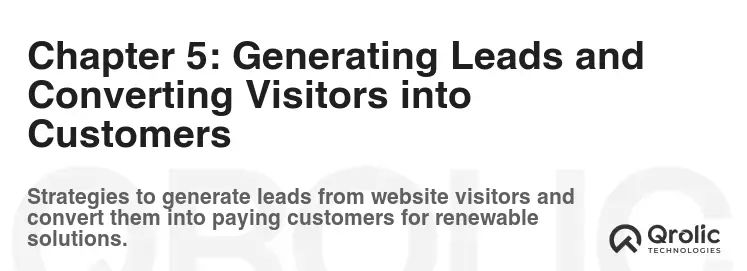
5.1. Call-to-Actions (CTAs): Guiding Visitors to Take Action
A call to action (CTA) is a prompt that encourages visitors to take a specific action, such as contacting you, requesting a quote, or downloading a resource. Use clear and concise CTAs throughout your website to guide visitors to take the desired action.
- Use Action Verbs: Start your CTAs with action verbs, such as “Contact Us,” “Request a Quote,” or “Download Now.”
- Make CTAs Visually Appealing: Use contrasting colors and prominent placement to make your CTAs stand out.
- Test Different CTAs: Experiment with different CTAs to see which ones perform best.
5.2. Lead Capture Forms: Building Your Email List
Lead capture forms are a crucial tool for building your email list and generating leads. Offer valuable resources, such as ebooks, white papers, or checklists, in exchange for visitors’ contact information.
- Keep Forms Short and Simple: Only ask for the information you need.
- Offer a Clear Value Proposition: Explain what visitors will get in exchange for their contact information.
- Use a Double Opt-In: Require visitors to confirm their email address to prevent spam and ensure a high-quality email list.
5.3. Landing Pages: Focusing on Specific Offers
Landing pages are dedicated pages designed to promote a specific offer, such as a product, service, or event. Optimize your landing pages for conversions by:
- Creating a Compelling Headline: Use a headline that grabs visitors’ attention and clearly communicates the value proposition.
- Writing Clear and Concise Copy: Explain the benefits of the offer in a clear and concise manner.
- Using High-Quality Images and Videos: Use visuals to showcase the offer and make it more appealing.
- Including Testimonials and Social Proof: Build trust by including testimonials and social proof.
- Making it Easy to Convert: Use a clear and prominent CTA to guide visitors to take the desired action.
5.4. Email Marketing: Nurturing Leads and Building Relationships
Email marketing is a powerful tool for nurturing leads and building relationships with your audience. Use email marketing to:
- Welcome New Subscribers: Send a welcome email to new subscribers to introduce your company and your products or services.
- Share Valuable Content: Share your latest blog posts, articles, and resources with your email list.
- Promote Your Products and Services: Promote your products and services to your email list.
- Offer Exclusive Deals and Discounts: Reward your subscribers with exclusive deals and discounts.
- Segment Your Email List: Segment your email list based on interests and demographics to send targeted messages.
5.5. Customer Relationship Management (CRM): Managing Your Interactions
A Customer Relationship Management (CRM) system helps you manage your interactions with customers and prospects. Use a CRM system to:
- Track Leads and Opportunities: Track leads and opportunities throughout the sales process.
- Manage Customer Data: Store and manage customer data in a central location.
- Automate Marketing Tasks: Automate marketing tasks, such as sending emails and scheduling social media posts.
- Improve Customer Service: Provide better customer service by having access to customer data and interaction history.
Chapter 6: Promoting Your Renewable Energy Website
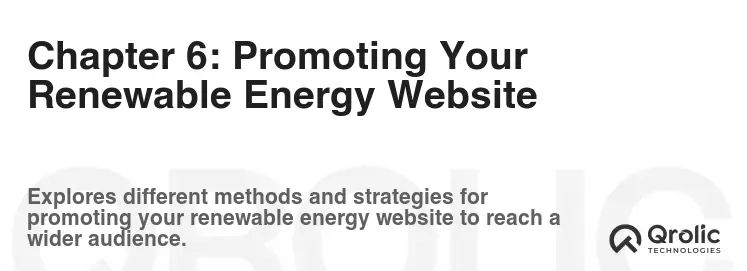
6.1. Search Engine Optimization (SEO): Getting Found on Google
As discussed earlier, SEO is crucial for driving organic traffic to your website. Implement the SEO strategies outlined in Chapter 3 to improve your website’s ranking in search engine results pages (SERPs).
- On-Page SEO: Optimize your website’s content and structure for search engines.
- Off-Page SEO: Build backlinks from other websites to improve your website’s authority and ranking.
- Technical SEO: Ensure your website is technically sound and easy for search engines to crawl and index.
6.2. Social Media Marketing: Engaging Your Audience and Driving Traffic
Social media marketing is a powerful tool for engaging your audience and driving traffic to your website.
- Choose the Right Platforms: Focus on the social media platforms that your target audience uses.
- Share Valuable Content: Share valuable content that is relevant to your audience’s interests.
- Engage with Your Audience: Respond to comments and messages promptly.
- Run Contests and Giveaways: Run contests and giveaways to increase engagement and attract new followers.
- Use Social Media Advertising: Use social media advertising to reach a wider audience and drive targeted traffic to your website.
6.3. Content Marketing: Creating and Sharing Valuable Resources
Content marketing is a long-term strategy that involves creating and sharing valuable content to attract and engage your target audience.
- Create a Content Calendar: Plan your content in advance to ensure a consistent flow of high-quality content.
- Promote Your Content: Promote your content on social media, email, and other channels.
- Repurpose Your Content: Repurpose your content into different formats, such as infographics, videos, and podcasts.
- Guest Blogging: Write guest posts for other websites in your industry to reach a wider audience.
6.4. Paid Advertising: Reaching a Wider Audience Quickly
Paid advertising can be a quick and effective way to reach a wider audience and drive traffic to your website.
- Google Ads: Use Google Ads to target users who are searching for keywords related to renewable energy.
- Social Media Ads: Use social media ads to target users based on their interests, demographics, and behavior.
- Retargeting Ads: Use retargeting ads to target users who have visited your website but have not yet converted.
6.5. Public Relations: Building Awareness and Credibility
Public relations (PR) can help you build awareness and credibility for your brand.
- Press Releases: Issue press releases to announce new products, services, or events.
- Media Outreach: Reach out to journalists and bloggers to get coverage for your company.
- Speaking Engagements: Speak at industry events to share your expertise and build your reputation.
- Awards and Recognition: Apply for awards and recognition to showcase your company’s achievements.
Chapter 7: Monitoring, Analyzing, and Improving Your Website
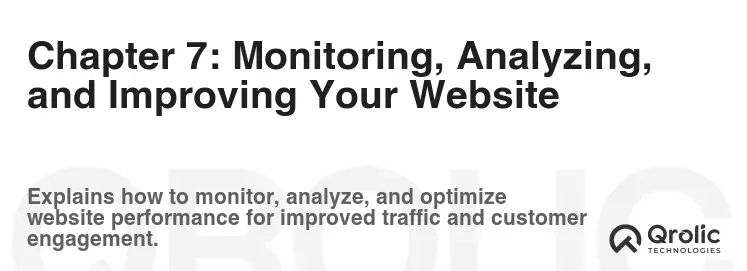
7.1. Website Analytics: Tracking Your Performance
Website analytics is essential for understanding how your website is performing and identifying areas for improvement. Use website analytics tools like Google Analytics to track key metrics, such as:
- Traffic: The number of visitors to your website.
- Bounce Rate: The percentage of visitors who leave your website after viewing only one page.
- Time on Site: The average amount of time visitors spend on your website.
- Conversion Rate: The percentage of visitors who complete a desired action, such as filling out a form or making a purchase.
- Keyword Rankings: Your website’s ranking in search engine results pages (SERPs) for your target keywords.
7.2. Heatmaps and User Recordings: Understanding User Behavior
Heatmaps and user recordings provide valuable insights into how users interact with your website.
- Heatmaps: Show where users click, scroll, and move their mouse on your website.
- User Recordings: Record users’ sessions on your website to see how they navigate and interact with your content.
Use heatmaps and user recordings to identify areas of your website that are confusing or frustrating for users and make improvements to enhance user experience.
7.3. A/B Testing: Optimizing Your Website for Conversions
A/B testing (also known as split testing) involves testing two versions of a webpage or element to see which one performs better. Use A/B testing to optimize your website for conversions by:
- Testing Different Headlines: Test different headlines to see which ones attract the most attention.
- Testing Different CTAs: Test different CTAs to see which ones generate the most clicks.
- Testing Different Images and Videos: Test different images and videos to see which ones are most engaging.
- Testing Different Layouts and Designs: Test different layouts and designs to see which ones are most user-friendly.
7.4. Gathering User Feedback: Listening to Your Audience
Gathering user feedback is crucial for understanding what your audience thinks about your website and identifying areas for improvement. Use the following methods to gather user feedback:
- Surveys: Conduct surveys to gather feedback on specific aspects of your website.
- Feedback Forms: Include a feedback form on your website to allow users to provide feedback at any time.
- User Interviews: Conduct user interviews to gather in-depth feedback from a small group of users.
- Social Media Monitoring: Monitor social media for mentions of your company and your website to see what people are saying.
7.5. Continuous Improvement: Staying Ahead of the Curve
The digital landscape is constantly evolving, so it’s essential to continuously monitor, analyze, and improve your website.
- Stay Up-to-Date: Stay up-to-date with the latest trends and best practices in web design, SEO, and marketing.
- Experiment with New Technologies: Experiment with new technologies to improve your website’s performance and user experience.
- Adapt to Changing User Behavior: Adapt to changing user behavior to ensure your website remains relevant and engaging.
Chapter 8: Qrolic Technologies: Your Partner in Renewable Energy Website Development
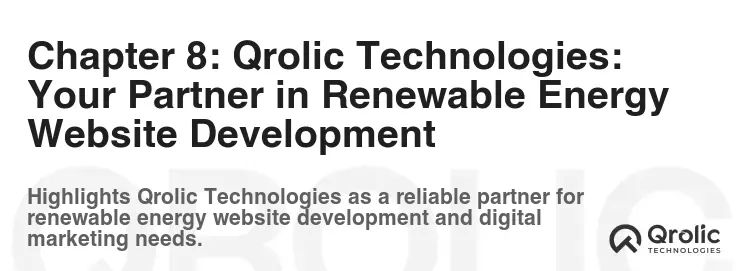
Qrolic Technologies (https://qrolic.com/) is a leading provider of web development and digital marketing services, with a proven track record of helping businesses in the renewable energy sector succeed online. We understand the unique challenges and opportunities that renewable energy companies face, and we are committed to providing our clients with customized solutions that meet their specific needs.
8.1. Our Expertise in Renewable Energy Website Development
Qrolic Technologies has extensive experience in developing websites for renewable energy companies of all sizes. We can help you with:
- Website Design and Development: We create visually appealing, user-friendly, and SEO-optimized websites that reflect your brand and attract your target audience.
- eCommerce Solutions: We develop eCommerce solutions that enable you to sell your renewable energy products and services online.
- Content Management Systems (CMS): We help you choose and implement the right CMS for your needs and provide training on how to manage your website’s content.
- SEO and Digital Marketing: We help you improve your website’s ranking in search engine results pages (SERPs) and drive targeted traffic to your website through our SEO and digital marketing services.
- Mobile App Development: We develop mobile apps that allow your customers to access your products and services on the go.
8.2. Why Choose Qrolic Technologies?
- Industry Expertise: We have a deep understanding of the renewable energy sector and the challenges and opportunities that companies in this industry face.
- Customized Solutions: We provide customized solutions that meet your specific needs and budget.
- Proven Track Record: We have a proven track record of helping our clients succeed online.
- Dedicated Support: We provide dedicated support to our clients to ensure their websites are always up and running smoothly.
- Competitive Pricing: We offer competitive pricing on all of our services.
8.3. Our Commitment to Sustainability
Qrolic Technologies is committed to sustainability and reducing our environmental impact. We use eco-friendly practices in our operations and encourage our clients to do the same. We believe that technology can play a key role in creating a more sustainable future, and we are proud to partner with renewable energy companies to help them achieve their goals.
8.4. Contact Us Today
If you are looking for a reliable and experienced partner to help you develop a renewable energy website, contact Qrolic Technologies today. We would be happy to discuss your needs and provide you with a customized solution that meets your specific requirements. Visit our website at https://qrolic.com/ to learn more.
Chapter 9: Common Mistakes to Avoid
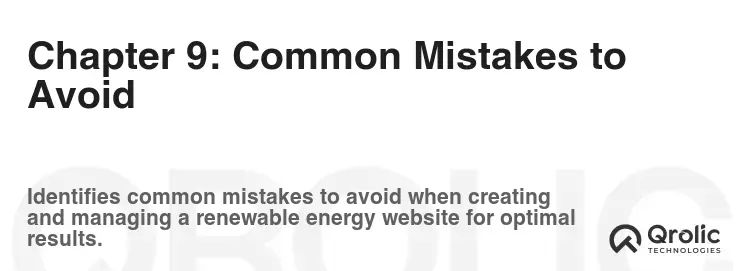
9.1. Neglecting Mobile Optimization
In today’s mobile-first world, neglecting mobile optimization is a fatal flaw. Ensure your website is fully responsive and provides a seamless user experience on all devices. Test your website on different screen sizes and devices to identify and fix any issues.
9.2. Ignoring Website Security
Website security is paramount. Neglecting security can lead to data breaches, malware infections, and damage to your reputation. Implement robust security measures, such as using a strong password, installing a security plugin, and keeping your CMS and plugins up-to-date.
9.3. Slow Loading Speeds
Slow loading speeds can frustrate visitors and increase bounce rates. Optimize your website for speed by compressing images, using a caching plugin, and choosing a reliable hosting provider.
9.4. Poor Navigation
Poor navigation can make it difficult for visitors to find what they are looking for. Ensure your website has clear and intuitive navigation, with a well-organized menu and a site map.
9.5. Lack of Clear Call-to-Actions
A lack of clear call-to-actions can result in missed opportunities to generate leads and drive conversions. Use clear and concise CTAs throughout your website to guide visitors to take the desired action.
9.6. Ignoring Analytics
Ignoring website analytics can prevent you from understanding how your website is performing and identifying areas for improvement. Regularly monitor your website analytics and use the data to make informed decisions about your website’s design, content, and marketing strategy.
Conclusion: Powering the Future with a Strong Online Presence
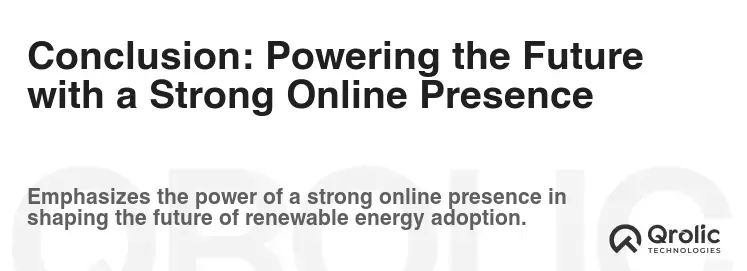
Creating a successful renewable energy website requires careful planning, execution, and continuous improvement. By following the steps outlined in this guide, you can create a website that attracts visitors, generates leads, and helps you achieve your business goals. Remember to prioritize user experience, SEO, and content quality. Embrace sustainability in your design and practices. The future is renewable, and a strong online presence is your key to unlocking its potential. Partner with experts like Qrolic Technologies to navigate the complexities and achieve your vision.
